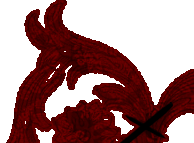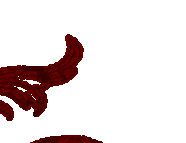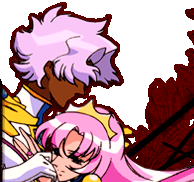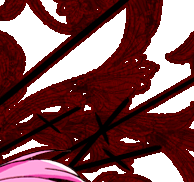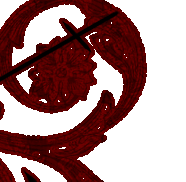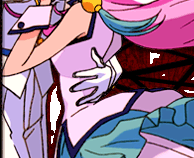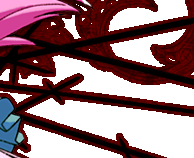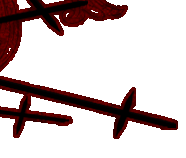
This analysis
was donated by Catherine.  The Dangers of Role Appropriation and Scripted Romance in Revolutionary Girl Utena As detailed by psychologists who study the influence of narratives, fictional
characters, and real-life role models on human identity construction, adolescence is a pivotal
time in terms of meaningful self-development. An adolescent's ability to discover and
experiment with various types of life stories and to identify with admired societal figures is
integral to his or her own subjective identity construction. These processes also affect the
cultivation of individuals' cherished sets of values, which can, in turn, impact their personal
goals, intimate relationships, and wider ethical conduct in complex cultural settings. As
psychoanalytic theorists and mythologists have espoused, imaginatively positioning oneself as
the central protagonist of one's own story can bolster self-confidence and conceivably even
provide one with a keen sense of purpose. However, in modeling oneself after heroic entities,
and in gleaning inspiration for the passage of one's own life from external, often hyperbolized
narratives, one must be wary of a specific and seductive trap. In romanticizing the identities of
others, and by participating in predominant, formulaic narratives, an individual runs the risk of
inadvertently losing his or her own unique identity in confining social scripts. In Kunihiko
Ikuhara's Revolutionary Girl Utena (Shōjo Kakumei Utena), the adolescent protagonist Utena
Tenjou's quest for meaningful identity construction leads her to fall in love with two very
different individuals, who inspire her in disparate ways and draw out very unique (and opposing)
traits in her. In the end, Utena must confront the reality that each of these relationships locks her
into a problematic social script — and subsequently reject each of the "roles" offered by her
amorous partners — before she can begin to clearly discern her own authentic set of values.  Imitating Royalty In Ikuhara's Revolutionary Girl Utena, a 39-episode animated series that aired from
April to December of 1997, Utena idolizes and identifies with a primary hero figure, and this
admiration causes her to inadvertently tumble into a set of social scripts. This does not become
apparent for quite a while, though, within the course of the narrative, and in fact, Utena's
emulation of this heroic role model is initially presented as a cause for celebration. The first
episode of the series opens with the following story, which is narrated by Utena herself and is
accompanied by stylized silhouettes of the relevant characters going through the mentioned
motions:
Once upon a time, many years ago, there was a little princess, and she was very sad, for
her mother and father had died. Before the princess appeared a traveling prince, riding
upon a white horse. He had a regal bearing and a kind smile. The prince wrapped the
princess in a rose-scented embrace and gently wiped the tears from her eyes.
"Little one," he said, "growing up alone in such deep sorrow, never lose that strength or
nobility, even when you are a young lady. I give you this [ring] to remember this day. We
will meet again. This ring will lead you to me one day."
Perhaps the ring the prince gave her was an engagement ring. This was all well and good,
but so impressed was she by him that the princess vowed to become a prince herself one
day. But was that really such a good idea?
I include the introduction in its entirety here because I wish to call attention to the
purposefully trite plot and language contained in the passage, and because it is repeated several
times over the course of the series—also a significant point. To begin with, some description of
the visuals that accompany this sequence will be useful. Though the characters' faces, hands, and
other exposed skin are shown only in blackened silhouette, their clothes are still "illuminated"
and visible. This alludes to the motif of shadow puppetry used elsewhere in the series as a
storytelling device; however, it also emphasizes the "costumes" the characters don, indicating
the ease with which individuals can take up and abandon new identities, but also stressing the
performative nature of the roles they explore. Utena and the prince's attire overtly borrows from
the imagery of stereotypical European royalty that decorates children's literature. The young
Utena's dress, at the start of the sequence, resembles that of an 18th century noblewoman, and the
prince is equally connotative. Allusions to 18th
century Europe pervade the entire series, and the story takes place in a seemingly western setting, so the introduction is thematically appropriate
on this level. The fabrics of the duo's costumes are light and pastel, and the two characters move
about gracefully, almost as if in a dance. The overall effect of these early visual cues is certainly
one of whimsy, but Utena's earnest narration also grounds it in the sincere. In the final two lines,
when Utena resolves to "become a prince herself," she reappears in an even more stereotypical—
and now, anachronistic—"royal" costume. Her puffed sleeves, stockinged legs, and uniformly
gold crown now bring to mind medieval Europe, showing some slippage in her definition and
understanding of the "prince." At this point, the ending question, "But was that really such a good idea?", seems
rhetorical, and even a bit perkily mischievous. Because Utena (now an adolescent attending the
prestigious Ohtori Academy) runs into all manner of troubles during the first several episodes
due to her "tomboyish" behavior, her desire to "become the prince" is presented as one that leads
her into exasperating but ultimately low-stakes conflicts, such as getting scolded by her guidance
counselor for flouting school rules. Most notably, Utena wears an altered version of her school's
uniform that more closely resembles the males' than the females', and this defiance earns her
multiple lectures about the importance of clearly delineated gender roles, much to her chagrin.
Utena's stated resolve to "become a noble prince who saves princesses" has lasted throughout
her childhood into adolescence, and she still wears the mysterious ring from her handsome
rescuer on a daily basis. Her constant references to him reveal that he is still a powerful influence
in her psychological life, and in fact, the courageous spirit that she has cultivated in his image
prompts her to defend the underdogs of the school. Utena's desire to be "noble" and to help
others, stemming from her idolization of the anonymous heroic figure from her past, does lead
her to seek justice for those around her. She is positioned as a small-scale, local hero herself, and
for this reason, it seems that the obvious answer to the question of whether or not this emulation
is a "good idea" is unreservedly affirmative. However, each time the introduction's central question is reiterated as the series
goes on, the answer becomes less clear. Eventually, the details of Utena's parents' deaths are
revealed, and it becomes apparent that she has exaggerated the grand narrative of her meeting
with the prince to mediate the pain she experienced upon their loss. The mention of their deaths
and of her emotional response, which are reduced to a single line in her self-constructed,
obsessively retold story, gradually come to light, destroying the pleasant illusion of her peace
with the event. Utena was never "a little princess," and she was much more than "sad" when her
parents abruptly died. In actuality, she was simply an ordinary girl, and when her family
perished, she went into such a deep depression that she contemplated suicide. It is true that Utena
met a prince, and that he encouraged her to retain her "strength and nobility" and gave her a ring.
It is also true that this encounter revitalized the young girl's spirit and convinced her to devote
herself to helping others in need, as she was helped herself. However, the matter of Utena's
ardent identification with the prince is called into question here, as the cracks in her rosy
narrative slowly begin to show. Each time the introduction as repeated, the language and
imagery seem less whimsical, innocent, and playful, and more off-kilter and disturbing. Utena's
conscious framing of the event in terms of a familiar, culturally pervasive fairy tale—through
such devices as the implementation of the "Once upon a time" standard opening phrase, and the
equally romanticized but chronologically incongruent prince costumes—exposes the extent to
which she is living in a fantasy world rather than in the real one. The story of the fairy tale prince rescuing the damsel in distress is problematic for
a number of reasons. However, it is important to acknowledge that Utena's positioning of herself
in this beautiful narrative is not necessarily the issue, and that in fact, many psychologists argue
that the invention of a cohesive life narrative is essential in dealing with trauma. Psychologist
Dan McAdams explores the importance of role models and idealized storytelling to successful
identity construction in his book, The Stories We Live By. McAdams suggests that it is a natural
function of the individual human mind to create metaphoric narratives that frame its values,
struggles, achievements, aspirations, and ultimately, identity. Influenced by Carl Jung and Erik
Erikson, McAdams explains that personal myths exist "to bring together the different parts of
ourselves and our lives into a purposeful and convincing whole...to make a compelling aesthetic
argument." Congruently, psychiatrist Laurence Kirmayer's writings mention the obstacles
presented by a "fractured life story" in psychotherapeutic treatment. In studying the
implementation of narrative therapy, social psychologist James Pennebaker concluded that
patients who were able to frame their painful memories within the larger structure of an
emotionally charged, but thoroughly structured story, were those who achieved the greatest
levels of catharsis and healing. In managing her trauma through the use of a romanticized story,
Utena is able to function in society and build several meaningful friendships, though of course
her psychological profile is far from perfect. McAdams also argues that individuals establish a cast of characters called "imagoes,"
similar to Jung's archetypes, which populates the mythology of their lives' journeys, and that
these encapsulated values can be based on or inspired by entities whose behavior we witness,
either staged or authentic. More simply put, both real and fictional individuals can serve as
the basis for another individual's bank of imagoes. In Utena's case, it is unclear whether she
identified with or aspired to be a "princess" figure prior to her parents' deaths and the encounter
with the prince. However, it is evident that her meeting with the noble figure directly inspired her
to simultaneously idolize and seek to embody him. In short, on the day Utena met the prince, two
separate imagoes were created within her. McAdams opines that "central conflicts or dynamics
in one's life may be represented and played out as conflicting and interacting imagoes, as main
characters in any story interact to push forward the plot." Herein lies the most troubling issue
for Utena. In her case, two primary imagoes are established, but rather than helping to sort out
a psychological impasse, they exacerbate it, pulling her in different directions both in terms of
personal identity and desired life narrative. Her fractured allegiance to the romanticized roles
of "prince" and "princess" cause internal conflicts to emerge within her that ultimately (and
ironically) obscure her own emerging identity. The tension created between these imagoes may
not be immediately apparent, but their opposing motivations and self-definitions present an
unusual array of contradictions. Consider again the recurring introduction. In spite of her non-royal status, Utena chooses
to portray herself as a princess in her own subjective memory. She considers the possibility that
the ring the prince gives her is an engagement ring, a loaded symbol of heteronormative female
fantasy. Though she says "This was all well and good," seemingly dismissing her desire to play/
identify with/embody the princess role, Utena is consistently torn between her traditionally
"feminine" impulses and her more assertive, "masculine" ones as the series goes on. To say that
she utterly rejects the lures of conventional femininity, as encapsulated by the archetype of the
helpless fairy tale princess, would be to overlook a significant part of her character. Yet Utena
also identifies with the prince, and this attraction is equally powerful and important. Outwardly,
she clearly considers her "true" identity to reside more in her tomboyish, "princely" inclinations
and actions more than her submissive, coquettish, and passive ones. Throughout the series,
Utena struggles to negotiate between these competing sides of her personality, trying to convince
herself and others that she can both wear a boys' school uniform, participate in physically
aggressive sports, and intervene on bullied students' behalf (i.e. embody/perform "masculine"
characteristics) and wear dresses, waltz, and enjoy being pursued in romance (i.e. embody/
perform "feminine" characteristics). The problem is that due to her overreliance on the
archetypal role models of the fairy tale prince and princess, Utena's perception of gender
becomes divided into a rigid binary. Qualities become polarized into "masculine" and
"feminine" categories, leaving little room for fluidity or flexibility. Utena constantly views her
potential adult identity as an either/or scenario, in which she must choose between embodying
the prince or embodying the princess. When love enters her life, offering her a chance to respond
to someone else's implicitly gendered treatment of her, this conflict rapidly escalates.
 The Problem with Anthy: Utena Becomes the Prince Over the course of the series, Utena develops a romantically and erotically charged
relationship with a fellow student named Anthy Himemiya, who plays a crucial role in the
advancement of the show's central adventure story arc in addition to serving as a love interest.
The young women's paths become intertwined when Utena witnesses a student council member,
a recalcitrant boy named Saionji, physically abusing Anthy. When Utena, motivated by her
desire to act with "strength and nobility," intervenes on Anthy's behalf, Saionji interprets her
challenge as a formal invitation to duel. His assumption is supported by the fact that Utena's ring
identically matches those of the other student council members, who orchestrate a covert series
of duels to determine who will be deemed worthy of accessing the mysterious (and vaguely
defined) "power to bring the world revolution." This cult-like society is organized and goaded on
from a distance by letters from a figure known only as "End of the World" (who later, in a
dramatic twist, turns out to be Utena's second primary love interest). Utena, simply wanting to
help Anthy, agrees to the duel and bests Saionji, subsequently learning that the current
"champion" not only takes one step closer to obtaining the "power to bring the world
revolution," but also becomes engaged to Anthy, whose formal title is "the Rose Bride." In this
context, the sex of the champion is irrelevant, and men as well as women battle for possession of
the Rose Bride. Anthy's wholly submissive attitude and her insistence that she must obey all
commands of her current fiancé(e) suggest that she has endured sexual as well as physical abuse.
This allusion is made more pronounced in the cinematic adaptation of Revolutionary Girl Utena,
which was targeted at a slightly older audience. Despite Utena's urgings, Anthy refuses to fight back against the system. As her character
develops, the extent to which her consciousness has been totally colonized by self-loathing
becomes evident. Anthy cannot combat her dehumanization because her captivity is more
symbolic than literal, and thus she is a perpetuator of her own abuse. Anthy is coded, throughout
the series, as a symbolic representation of women's participation in patriarchal order. She is
presented as long-suffering, yet somewhat masochistic; she is an obedient yet resentful "object"
that buckles under the whims of the agentic "subjects" around her. She is, in short, an archetypal
embodiment of the most damaging aspects of female subordination. A complicated figure, she is
neither the helpless victim that she first appears to be, nor the "witch" who, according to her
brother as he calmly watches her writhe in bodily pain, "can no longer be happy except like
this." For a long time, though, Utena neglects to acknowledge the moral and psychological
complexity within her friend, instead conveniently categorizing her as a delicate damsel in need. In spite of Utena's disgust with the council of duelists and their objectification of her
friend, she decides to participate in the system in order to prevent Anthy from falling into the
hands of someone less compassionate. Utena fights in the hopes of achieving the "power to
bring the world revolution," which she believes will end the duels, and thus the subjugation of
Anthy. The problems with this rationale are somewhat overt, but Utena is so utterly consumed
by the desire to act chivalrously toward her friend, whom she sees as helpless and meek, that she
entirely overlooks them. As Utena's feelings grow stronger and turn from duty into love, this
desire intensifies all the more. Thus, she falls into a troubling social script, ignoring the specifics
of her present situation and letting her romantic notions about heroes and heroics get the best of
her. In short, Utena begins to play "the prince" to Anthy's "princess," and this sets both women
on a trajectory that can only end in sorrow. In her essay "Legacies of Tortured Sensibility; or, what Shakira learned from
Sade," literary analyst Courtney Wennerstrom discusses "the fine line between empathy
and...masculinist liberation fantasies." She notes that such fantasies "occur at the cost of injured
flesh and extracted hearts" and that yet these injuries are mere "façades or faux surfaces that
endlessly unfold to oblivion." So it is with Utena and Anthy. Utena strives to walk the fine line
between empathy and masculinist liberation fantasy, but temporarily and tragically fails due to
her over-identification with the "prince" and his corresponding narrative. In short, she acts
paternalistically toward her friend, seeking to "fix" and "correct" Anthy's being. Instead of
seeking to understand or collaborate with Anthy, Utena appoints herself the sole and omnipotent
savior of her friend's woeful life. Although Utena's "orders" to Anthy are well-meaning — Utena
encourages her to socialize more and to seek healthy friendships, for instance — Anthy still
"obeys" because she is the Rose Bride, not because these situations are comforting, pleasant, or
something she genuinely desires. Utena strives to create an egalitarian, non-hierarchical
relationship with Anthy, but her paternalistic attitude undermines her efforts. Interestingly, this
dynamic also carries some racial undertones, as Utena is light-skinned, and Anthy is darkerskinned, and also wears an Indian bindi. Some fans have speculated (and I agree) that given the
relative absence of non-white characters in much of Japanese animation, that the tensions
inherent in this relationship can be taken as a critique of western, liberal, second-wave feminism.
In any case, while Utena means to act out of empathy and virtue, her endeavors to capture and
mimic the essence of the noble, heroic, and male-coded prince figure lead her to indirectly
contribute to Anthy's subjugation. Various feminist theorists have analyzed the complications that can often arise when a
female individual seeks to identify with and emulate male role models, especially in literature
and other types of fiction-based media. Literary theorist Judith Fetterley, in her landmark text
The Resisting Reader, famously introduced the idea of "immasculation," or the voluntary
repression of "feminine" characteristics in female readers who wish to be treated with respect
in intellectual circles. More recently, in her book, Ink-Stained Amazons and Cinematic
Warriors, cultural critic Jennifer Stuller explores the troubling collapse between the very
concept of heroism and the historically male-coded fascination with violence, domination, and
individualism. Wennerstrom's labeling of liberation fantasies aimed at suffering female bodies as
"masculinist" is no accident; there is clearly some agreement among feminist writers that certain
"heroic" tendencies are associated with or culturally linked to the constructs that define male
behavior. Especially in the case of action-adventure and fantasy stories (of which Utena is
one), this erasure of female presence may be due in part to popular culture's frequent reliance on
the formula of the hero's journey when crafting marketable storylines. This journey, as theorized
by Joseph Campbell, Northrop Frye, and other mythologists, has served as the basis for countless
epics and fairy tales, both historically and contemporarily. On the surface, the idea seems simple
enough—even obvious. Heroes heed a call to action that draws them away from their
comfortable and familiar homes, descend into an altered, "underworld" territory where they
overcome terrifying foes, and ultimately reemerge stronger and wiser than before. It could be
argued that there is a certain universality to this narrative arc, and that at its heart, the hero's
journey reflects a very basic cycle of peace, conflict, and resolution. Yet the pervasiveness of
this model may be problematic. It colors our expectations of what truly constitutes an interesting
and worthwhile story, almost to the exclusion of alternative types of narratives. In doing so, it
may also aid in the normalization of certain values and behaviors marked by undertones of
violence and domination. If nothing else, it promotes a certain set of principles that define what
"the hero" should be. Fetterley, Stuller, and other feminist critics argue that if we take our
notions about the archetype of the hero for granted, so too do we blind ourselves to the
underlying rhetoric concerning virtue, entitlement, and, notably, gender that they contain.
In short, these theorists and others suggest that the "hero" of Campbell's marvelous
mythic journey is an inherently patriarchal agent, even when such a figure appears in a female
body. A hero that undertakes this journey frequently achieves victory by using destructive and
aggressive forces, impulses that do not reflect the more cooperative and compassionate ideals
that many feminists espouse. Furthermore, Campbell's hero almost always succeeds alone,
though supporting characters may offer minor assistance along the way. Although some may
argue that the hero ought to be a vessel of the extraordinary and that this kind of exceptionalism
is ultimately nothing more than a benign fantasy, such recurring representations of isolationism
can diminish the importance of community and glorify ideals of hyper-individualism. Finally, the
fact that the protagonist is often prompted to begin the journey on account of a prophesy or other
predetermined assignment of "hero" status strikes some as problematic. Community organizer
Dave Meslin criticizes narratives such as Harry Potter and The Matrix trilogy, for instance,
because they center on "chosen ones" who have greatness thrust upon them rather than choosing
it themselves; they are compelled to complete heroic deeds by external rather than internal
drives. Meslin argues that one of the key points of leadership is that "it comes from within." In
perpetuating the notion that heroes are born and not made, such stories may contribute to the
misconception that heroism is a solitary, elite, and even biologically deterministic attribute.
Significantly, Meslin critiques narratives starring female protagonists in this analysis as well. Utena's quest to "become the prince" is, in essence, a quest to become a hero, and
unfortunately, her conception of heroism is problematically implicated in values of hypermasculinity. Firstly, the bestowal of the ring by the prince marks her as a sort of "prophesized"
or predetermined hero, a fact that she recognizes and embraces. Additionally, in trying to
model herself after her childhood hero, she unintentionally begins to resemble an arrogant,
even narcissistic tyrant in her dealings with Anthy under the guise of altruism. Finally, instead
of creating a new and original life narrative using the hero's journey as a source of inspiration,
Utena begins to participate in a problematic and andocentric social script. In her overreliance on
tropes of fairy tale heroes, the gendered subtexts of her chosen imagoes, and their corresponding
narratives with regard to her own identity construction, she becomes the "prince" to Anthy's
"princess" in the worst possible ways, negating her friend's own sense of agency and power.
 The Problem with Akio: Utena Becomes the Princess In total contrast, in her relationship with Akio, Anthy's dashing and enigmatic older
brother, Utena falls victim to a very different social script. In spite of her consciously cultivated
courage and level of comfort with dismissing men who seek to woo her through flattery and
other stereotypical courtship tactics, Utena gradually succumbs to Akio's subtle yet assertive
charm. Predictably, his intentions are less than pure; Akio desires to manipulate Utena for his
own twisted purposes, and does not truly care for her in the least. As he slowly gains the
protagonist's trust, he also wears down her resolve to act as a noble and heroic "prince" figure.
Ultimately, his acquisition of control over her is achieved through explicitly gendered methods.
Akio seeks to transform Utena from the sprightly, confident, and valiant individual she is into a
meek, submissive, and delicate "princess," and because a part of her identifies with this extreme
end of constructed femininity, his scheme very nearly succeeds. As he performs the role of the
perfect prince, she responds by playing the part of the idealized princess, just as he intends. Akio lures Utena into the trap of scripted behavior that detracts from her own authentic
identity construction through several means. Unbeknownst to Utena, Akio is aware of her desire
to reunite with/embody her childhood hero, and he uses this yearning against her. First of all, he
is at an immediate advantage because he bears an uncanny physical resemblance to her cherished
prince. Furthermore, he seeks to present himself as an immediately attainable alternative to and
replacement for the absent nobleman. Namely, Akio gallops about on a white horse, conflating
himself visibly with the prince, and pretends to advocate for Anthy, whom Utena loves and in
whom she may perceive a reflection of her younger, vulnerable self. In doing so, he presents
himself as an upstanding gentleman concerned with others' welfare, appealing to Utena's inner
"princess" imago. She is startled by this resemblance, and even questions it at one point, musing,
"It's too much. An actual prince on a white horse?" Yet in spite of her suspicions, and in spite of
the fact that Akio is engaged to another woman, she allows herself to develop passionate feelings
for him, suspending her better judgment. Beneath the suave exterior, Akio is an utter scoundrel. In contrast to Anthy, who is coded
as an embodiment of female subjugation, Akio represents the most sinister qualities of
patriarchy. He participates in sexual relations with several members of the main cast, as well as
minor characters, including the mother of his own fiancée. In many cases, these trysts seem
irrelevant to the progression of the plot, and I would suggest that their hyper-exaggerated
prominence serves no other purpose than to symbolically illustrate the extent to which patriarchy
impacts/infiltrates everyone. Moreover, Akio is secretly the infamous End of the World, who has
been organizing the very dueling system that locks his sister in psychological and physical
captivity. In the end, it is revealed that Akio and Utena's childhood prince are actually one in the
same, although Akio considers himself divorced from his former self. In fact, it is his endless
agony over losing his own former "strength and nobility" that causes him to ravage the lives of
others. His inability to live up to his standards of the perfect storybook prince leaves him feeling
worthless and culturally impotent, signaling once again the dangers of unchecked hero worship. His solution to this is to transmute Utena into an "unmatched princess," a goal he tends to
in private but also shares with his naïve lover publicly. The young woman is unable to withstand
his appeals to her inner princess imago, and she migrates increasingly toward the stereotype of a
helpless, demure damsel. Interestingly, one of Akio's methods of colonizing Utena's
consciousness involves convincing her to alter her body. Throughout the vast majority of early
episodes, Utena appears in her standard customized "boys'" school uniform. As Akio and Utena
continue dating, however, she appears in several casual, feminine outfits, and other characters
begin to notice (with some concern) that she looks and behaves in a more traditionally "girlish"
manner. Akio sends Utena a pair of flashy earrings that she wears in spite of initial hesitations
("they don't suit me," she insists), and teasingly offers to replace her duelist's ring with one
"more suited to [her] new look." Notably, in the early scenes of the episode in which Utena gives
her virginity to Akio, she is wearing a revealing dress. These details are significant because
earlier in the series, the audience has learned to associate Utena's adornment in female clothes
with the character's discomfort, or even unhappiness. In the most telling instance of this, she
wears the ordinary girls' school uniform as a pointed, nonverbal expression of sadness and
defeat. We learn to believe that a visibly tomboyish Utena is a happy Utena, and thus, when she
concedes to primp herself up for Akio's pleasure both in manner and garb, it is narratologically
distressing. This visual conflict reaches its climax when, in the penultimate episode, Akio
forcibly dresses Utena in a princess costume almost identical to the one Anthy wears as the Rose
Bride, symbolically erasing all trace of her own identity and attempting to clinch her absorption
in the social script of the submissive, dehumanized woman. Coming of age and dealing with the
inevitable sexualization it brings are recurring themes in the series, but nowhere is the latter
presented as a source of emotional tension more vividly than in this evolving dynamic. The way Akio would have it, growing up for Utena would mean growing into a
quiet, obedient princess. Correspondingly, given the series' heavy allusions to fairy tale tropes
and clichés, this can be seen as another feminist critique. Feminist theorists observe that in
countless myths and traditional western fairy tales—as well as in contemporary stories—the
female life is seen as an inevitable trajectory toward marriage and motherhood, and that this is
posited as "common sense." Admirable women obey this path, while "abject" women resist it.
As cultural critic Andrea Dworkin argues, "There are two definitions of woman [in fairy tales]
...The good woman must be possessed. The bad woman must be killed, or punished. Both must
be nullified." Other critics, including Margaret Atwood and Anne Sexton, similarly note that
female characters within popular heroic narratives tend to be funneled into one of two fates:
marriage or death. The idea of a free and autonomous female agent surviving the standard hero's
journey without succumbing to one of these endings is apparently cause for an anxiety that is
deeply rooted in cultural norms. In addition to exploiting Utena's desire to embody/perform the
role of the "princess," Akio attempts to derail her entire life narrative by conflating maturation
with willing objectification in her mind. He stunts her psychological growth both as a human and
a woman, and Utena is too enamored with her romanticized fairy tale narrative to notice his
subtle violence.
 "Revolution?" Ultimately, Utena rejects both of the social scripts offered by her lovers, refusing to play
the role of the complementary "other" to either of their hyperbolized archetypes. Though
realizing that she can neither be the noble prince to Anthy's suffering princess nor the blushing
princess to Akio's charming prince is painful, it is vital for Utena's departure into independent
identity formation. When she learns the truth about Akio's machinations as End of the World
and his long-term abuse of Anthy, Utena physically attacks him, ending their relationship and
her delusions about an impeccable storybook ending. Moreover, when Anthy attempts suicide,
Utena is forced to confront the fact that she has been seeking to liberate her friend for the
glorification of her own "prince" imago rather than to genuinely help her. She confesses, "I
never realized the pain you were in. I never noticed how much you were suffering. And despite
that, I kept acting like I was a noble prince who could save you! The truth is, my protecting you
was just for my ego!...I was the one who cheated you. I was the one who used you." In breaking
from both the male-coded epic narrative of the heroic, if individualistic fairy tale prince, and the
trajectory of the "good" fairy tale princess who happily weds, Utena puts herself at risk of
tumbling into their narratological inversions. That is, had her will been weaker, she could have
interpreted these departures as indications that she was "truly" a villainous figure, and upheld
heteronormative gender roles in a disparate, though equally problematic way. But instead, she
avoids becoming the deadly patriarch and the abject witch; she disposes of narrative maps
entirely and begins anew. In observing Utena's attempts to grapple with her parents' untimely death, Saionji
remarks that although the arrival of the prince saved her from suicidal tendencies, "she's still
trapped in that coffin." He then adds, "No, it's not just her. We're all trapped in our coffins." The
coffin here symbolizes denial, or refusal to deal with the realities of one's psychic or bodily
trauma. It represents, in short, the refusal to craft and hone a unique and unscripted identity that
is not predetermined by reliance on romanticized narratives or archetypal standards impossible to
attain. In the end, though Utena has left the school and her fate is left uncertain, Anthy insists
that the "revolution" sought by the duelists has indeed occurred. Utena "failed" to rescue her
through brute force alone, she did enable Anthy to find her own voice and the courage to act on
her own behalf. In their final moments together, as Utena counsels Anthy's innermost anxieties—
represented by a nude version of the girl, curled in the fetal position inside a coffin—she extends
her hand and coaxes, "I came all this way to be with you, so don't be afraid of this world where
we can meet" (emphasis added). In stressing that she wants to be "with" Anthy and to "meet"
her, as opposed to "save" her (and in doing so, negate her own agency), Utena demonstrates that
she has abandoned her old notions of heroism. As she reaches out in the spirit of partnership and
collaboration, Utena demolishes the condescending hierarchy that was set up between her and
Anthy. In the end, Anthy proudly leaves the Academy on her own two feet and of her own free
will, scorning her brother as she leaves: "You really don't know what's happened, do you? It
doesn't matter. By all means, stay in this cozy coffin of yours, and continue to play prince."
Akio is left with his fractured obsession with the "prince"—a body of ideals that he can never
fully embody—while Anthy departs from the patriarchal order of the school to reunite with
Utena and commence a more genuine relationship. Northrop Frye writes that humanity "lives in two worlds, the world of nature and
the world of art [it] is trying to build out of nature. The world of art, of human culture and
civilization, is a creative process informed by a vision." In seeking to construct a meaningful
and functional life narrative, it is challenging to navigate the balance between imagination and
reality. As psychologists and mythologists have espoused, framing one's life in romanticized
terms can bestow a powerful sense of purpose, and even help to mediate trauma. Yet
overreliance on external characters, figures, and storylines can result in individuals' participation
in troubling social scripts. With regard to memory, romance, sexuality, gender performance, and
even ethical conduct, these imagoes and narratives can help us to strive for our best possible
selves, or overtake our nascent steps toward originality. In Revolutionary Girl Utena, Utena must
perform two disparate and diametrically opposed roles before she can discern the need of a new
and less polarized collection of values. In the end, she must learn to legitimately become the hero
of her own compelling story.
 Note: Parts of this argument are developed further in my articles “Prince Charming by Day, Superheroine by Night? Subversive Sexualities and Gender Fluidity in Revolutionary Girl Utena and Sailor Moon,” which can be found in Colloquy: Text Theory Critique 24 (2012): 207-222, and “Her Story, Too: Final Fantasy X, Revolutionary Girl Utena, and the Feminist Hero’s Journey,” which is forthcoming in an anthology tentatively titled Heroines (Lanham: Scarecrow Press, 2014). Feel free to contact me with questions at catherine. e. bailey AT wmich.edu.
 Works Cited and Consulted Cambell, Joseph. The Hero With a Thousand Faces. New York: Pantheon, 1949. Print.
Dworkin, Andrea.Woman Hating. New York: E. P. Dutton, 1974. Print.
Farwell, Marilyn. Heterosexual Plots & Lesbian Narratives. New York: New York University
Press, 1996. Print.
Fetterley, Judith. The Resisting Reader: A Feminist Approach to American Fiction.
Bloomington: Indiana University Press, 1978. Print.
Frye, Northop. The Secular Scripture: A Study of the Structure of Romance. Cambridge: Harvard
University Press, 1976. Print.
Laws, Judith Long and Pepper Schwartz. Sexual Scripts: The Social Construction of Female
Sexuality. Washington, D.C.: University Press of America, 1977. Print.
Meslin, Dave. “The Antidote to Apathy.” Online video clip. TED: Ideas Worth Spreading. TED,
Oct. 2010. Web. 7 Oct. 2011.
Kirmayer, Laurence. “Toward a Medicine of the Imagination.” New Literary History 37.3
(2006): 583-601. Print.
Pennebaker, James W. Opening Up: The Healing Power of Expressing Emotion. New York:
Guilford Press, 1990. Print.
Revolutionary Girl Utena. Dir. KunihikuIkuhara. TV Tokyo, 1997; Central Park
Media/Software Sculptors, 1999. DVD.
Stuller,Jennifer K.Ink Stained Amazons and Cinematic Warriors: Superwomen in Modern
Mythology. New York: I. B. Tauris, 2010. Print.
“The Dark Bride and the Pale Prince.” GAR GAR Stegosaurus. Wordpress, 25 Feb. 2010. Web.
19 Nov. 2011.
Wennerstrom, Courtney. “Legacies of Tortured Sensibility; or, what Shakira learned from Sade.” Western Michigan University. Kalamazoo, MI. 14 Nov.2011. Lecture.
 |

